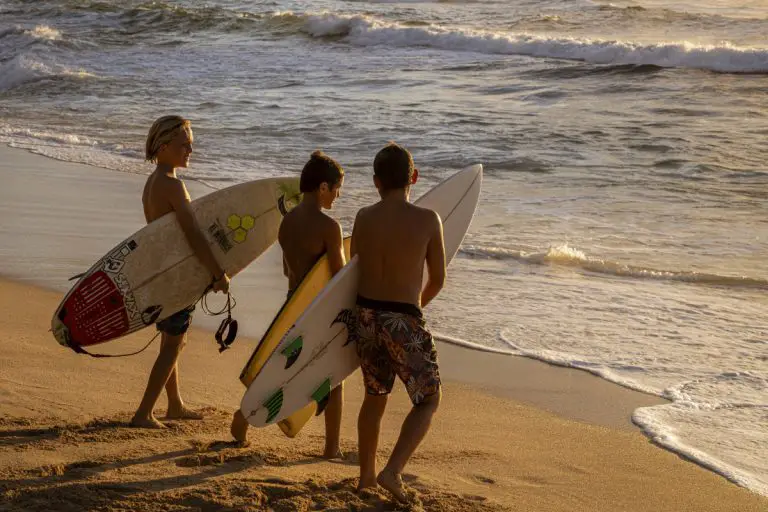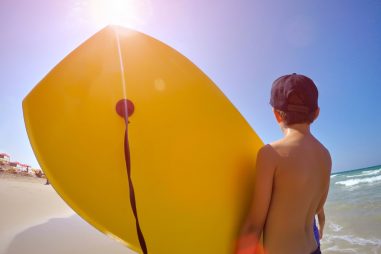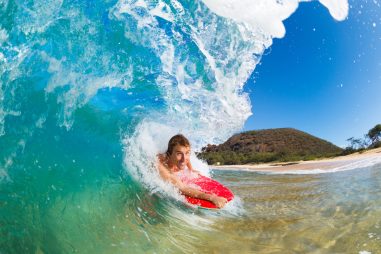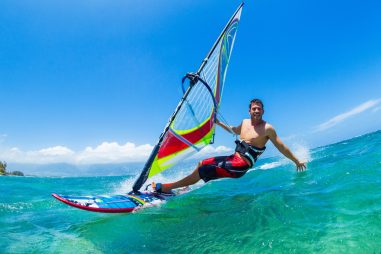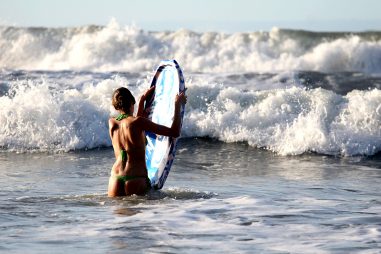Boogie boarding takes only a couple of hours to learn compared to surfing. Also, being in a prone position makes it easier to balance the board than standing up. Boogie boarding is popular too because it’s generally safer for all ages compared to surfing.
Is Boogie Boarding Considered Surfing?
Boogie boarding and surfing are different and not considered the same. Other than the difference in the type of board you use, surfing requires that you stand on the board, while boogie boarding lets you lie flat on the board as you drift on the water. You can learn how to boogie board in a day, but you may need more when you practice surfing.
Boogie boarding was not a welcomed sport during its introduction. Many surfers thought of boogie boarding as a degraded way of surfing and considered it inferior. Later on, competitions emerged, and new tricks rose to fame. It is now considered a sport in its own right and is no longer comparable to surfing.
Is Boogie Boarding Similar to Surfing?
There are few similarities between boogie boarding and surfing, but their similarities offer incredible advantages. They are both overall good for your physical and inner well-being. Here are some similarities between boogie boarding and surfing to find out some more.
- Physical Fitness: Both sports improve your cardiovascular health, which is an overall advantage for breathing and performing strenuous activities. It lessens the risk of any heart-related problems.
- Mental Well-Being: Boogie boarding and surfing are perfect ways to relax the body and mind. It’s an incredible way of relieving stress and taking your mind off things.
- Muscle Tone: Because of the continuous paddling and balance, both sports help improve your overall muscle tone.
- Improved Flexibility: You will do many twists and turns with your body as you try different maneuvers in the water, enhancing your flexibility and mobility.
- Nature: Boogie boarding and surfing allow you to be constantly in the ocean. It positively impacts your overall health and helps you become stronger.
- Family and Friends Activity: both of these sports give time for family and friends to bond! You do not need to be a professional athlete when you share the same passion with your family and friends. It brings everyone together.
- Waves: The waves between boogie boarding and surfing are different, but they share the same passion for riding them. You are constantly looking for waves to take on when boogie boarding and surfing.
- Wax: Of course, any boogie board and surfboard will need wax to help improve their grip and maximize their boogie boarding and surfing experience.
Boogie boarding may be considered an introductory sport to surfing. They came from a similar history, but because they are different sports with different rules, the argument of whether which sport is better or whether they are the same is no longer a debate.
How Is Boogie Boarding Different From Surfing?
There are many differences between boogie boarding and surfing. For instance, one main difference is how you ride your board. Another big difference is the kind of waves you can ride. There are pros and cons to both of these sports. But to have a better understanding of how different they are, read on below:
Advantages of Boogie Boarding Over Surfing:
- Riding a boogie board requires you to be in a prone position.
- Riding a boogie board is more undemanding than on a surfboard because of the difference in body stance.
- You can ride more intricate waves in boogie boarding than in surfing. There are waves that a boogie board can ride that are not possible in surfing.
- Compared to surfing, which relies on the weather, you can boogie board on any wave.
- Boogie boarding can be for everyone. On the other hand, Surfing may limit people with old age or those with underlying conditions.
- Boogie boarding is more stable in the water and simple to balance than surfing.
- Boogie boards are more portable and unchallenging to carry than surfboards.
- Boogie boards are cheaper than surfboards because of the materials used.
- You can learn boogie boarding faster than surfing.
- Boogie boarding is generally safer than surfing.
Advantages of Surfing Over Boogie Boarding:
- You can stand and be in a laying position when surfing.
- Surfing only requires your swimwear or rash guard and your board, whereas you will need a swim fin or socks in boogie boarding.
- There are tricks you can perform on a surfboard and maneuvers that you will not be able to on a boogie board.
- Surfing provides challenge and room for creativity.
- The payoff when you practice surfing is better than on a boogie board.
- Surfing can boost your confidence.
- Surfing can help you develop problem-solving abilities when faced with challenging situations.
- Surfers can ride large waves that boogie boarding enthusiasts would not be able to.
- There is an enormous feeling of gratification once you are able to surf well and perform various techniques.
- There are varying boards you can use in surfing, depending on your level of skill and expertise.
There are many differences between boogie boarding and surfing. Because they are both different sports, with different rules and takes on waves and maneuvers on water, the preference will be entirely up to you.
What Is the Difference Between a Boogie Board and a Surfboard?
One of the direct differences between a boogie board and a surfboard is their size. Boogie boards consist of foam or plastic and are shorter and lighter, making them a portable choice than a surfboard. Conversely, surfboards are longer and heavier because it consists of wood or foam and reinforced plastic.
Here are additional guidelines to showcase their differences.
- Execution: Surfers stand on their surfboards to glide through large waves. In boogie boarding, you lie with your stomach on the board directly as you ride the waves. Some make boogie boarding more challenging by kneeling on their board or, in rare instances, standing up.
- Ease of Riding: You can learn how to boogie board within an hour because of the ease of riding the wave while lying on your board. Surfing may require lots of practice before you can even stand up. This distinction is the reason why surfers believe that their sport is superior to boogie boarding.
- Price: Surfboards are expensive compared to boogie boards. Boogie boards are also more available and only cost as little as $20, while high-quality boogie boards cost over $400. Surfboards generally cost about $200 to $1200.
- Type of Board: Boogie boards are obviously shorter than traditional surfboards. This difference is why the maneuvers and tricks you can perform on both of these boards are different.
- Techniques: Because of the distinct body stances between boogie boarding and surfing, the maneuvers are different. Most would say that surfing still provides more challenging tricks, while some boogie boarding enthusiasts claim they have more creativity in their sport.
- Access to Waves: Surfing requires waves large enough for them to ride on. Not every day is a good surfing day, and some may need to wait for an entire season. Boogie boarding, on the other hand, can freely access waves small waves that surfers cannot. It gives it more flexibility than surfing.
Because a boogie board is shorter, standing on your two feet is not ideal unless you are a professional drop-knee enthusiast. However, there are certain advantages, such as riding short breaks and hollow, fast-breaking waves. A surfboard is recommended in large waves and waves farther from the shore.
Does Boogie Boarding Help With Surfing?
Boogie boarding can help you prepare for surfing. Both of them require that you ride the waves, so it helps you learn how to read them and understand the ocean. It’s a perfect way for beginners to get used to the ocean’s currents. They will also be able to practice timing and balance, which are both necessary in surfing.
Many claim that boogie boarding is an introductory sport to surfing, but boogie boarding enthusiasts disagree.
Although boogie boarding introduces initial aspects to surfing, not everything you can do on a boogie board can apply to a surfboard. For example, a good advantage in boogie boarding is knowing when to ride and how to ride the waves, which is fundamental to surfing.
Can You Learn to Surf on a Boogie Board?
Boogie boarding offers a variety of creative tricks, and surfing is one of them. A stand-up bodyboard is a technique many advanced and professional boogie boarders use to ride the water while standing on a boogie board. This technique needs a low body stance and incredible balancing. It also requires a different boogie board to support your body weight.
Steps to Do a Stand-Up Trick on a Boogie Board:
- Start by paddling towards a wave of your choice.
- Grab the rails of your boogie board with your hands as you prepare to catch the wave.
- Extend your arms to raise your upper body and allow your feet to touch the board. They must be on the board at the same time.
- Your front foot must be on the middle section of the board, closer to the nose.
- Your backfoot must be on the back tail of the board.
- Keep a low stance and allow for some balance.
- Ride the wave.
Compared to traditional surfing, it may be harder to surf on a boogie board. You will also need to learn tricks such as spins, cutbacks, and drop-knee before you can begin to practice this maneuver. Also, remember that it’s not advisable to use fins when standing on your board.
Is Boogie Boarding Easier Than Surfing?
Yes, boogie boarding is less complicated and easier to learn than surfing. Boogie boarding helps you practice balance, but there isn’t much work involved because you’re lying on your board. Here is a list of reasons why boogie boarding is much easier than surfing:
- Because boogie boards are shorter than surfboards, hitting a wave feels more natural.
- You can wear swim fins/flippers in boogie boarding, which allows you to catch the wave easily.
- The short size of a boogie board allows for easier paddling and maneuvering.
- Boogie boarding is a sport you can learn in a couple of hours.
- Boogie boarding only requires that you get the correct timing to catch the wave and does not need you to stand up first to ride them.
- Boogie boards are easier to carry and more portable than a surfboard.
- Because you can learn boogie boarding within a day, your next practice can focus on beginner tricks that will make it more challenging. On the other hand, surfing may take you a while before you can even begin to perform tricks.
- Boogie boarding is physically less demanding than surfing.
- There is a smaller chance of getting into an accident in boogie boarding compared to surfing.
- Lying with your stomach on the boogie board offers more stability, making maneuvers easier.
You can ride your boogie board by simply lying on it with your stomach and using your body weight to control your direction. To make boogie boarding challenging, you can also learn advanced tricks. However, some of these tricks are still easier than tricks you perform on a surfboard.
Is Boogie Boarding Safer or More Dangerous Than Surfing?
Boogie boarding is generally safer than surfing. It doesn’t mean, though, that it doesn’t require safety precautions. Most accidents in boogie boarding occur because people underestimate the risk and overestimate their safety. It can be as dangerous as surfing if you don’t meet the safety precautions provided below:
- Be a skilled swimmer. You should know how to get back to the shore when you can’t rely on your boogie board.
- Be aware of other surfers/swimmers around you. When you are in the deep water and there is a wipeout, surfers may potentially hit you. Make sure you have enough distance to ensure you don’t hit anyone.
- Riding large waves can be a thrill but avoid them, especially when using beginner boogie boards. Ride waves within your level as they can be dangerous.
- Don’t ride a wave that breaks on the shore, as it may cause you serious injuries.
- A common accident for beginners is nose-diving on the sand. Work on landing on the sand by using your body weight and pointing the nose upward.
- Always wear your leash. Doing so will keep your boogie board within reach in case you fall off your board.
- Like how it is with surfing, don’t go riding alone. It is always best to have someone readily available to help you in an emergency.
- Another similar hazard with surfing is not checking your board regularly. Checkups will prevent any accident from happening and keep your board from malfunctioning.
- Get a good warm-up exercise before going to the water. It will avoid excessive fatigue while in the water and cramps.
- It’s always an ideal recommendation to enroll in a boogie boarding lesson, like how it is with surfing. It will make sure you are safe at all times, and you can get the most out of your boogie boarding experience.
Boogie boarding is safe as long as you are aware and follow the safety precautions. Following these precautions will also avoid causing an accident to someone else. Always go to a beach monitored by a lifeguard.
Should You Boogie Board or Surf?
Choosing between boogie boarding and surfing is entirely up to your preference. Boogie boarding and surfing are both incredible sports to learn, with a variety of advantages. They both open doors to creativity and take perseverance to master.
Consider what you are willing to invest when choosing between these two sports. For instance, recognize the price point, safety, the type of waves available near you, and your level of commitment. Doing this will make sure you can get the most experience out of the watersport of your choice.
Boogie boarding and surfing are both different sports but share a similar passion for riding the waves. Learning boogie boarding is less complicated than surfing, but it’s a great way to introduce the fundamentals of surfing. It’s also generally safer, as long as you follow safety procedures.

